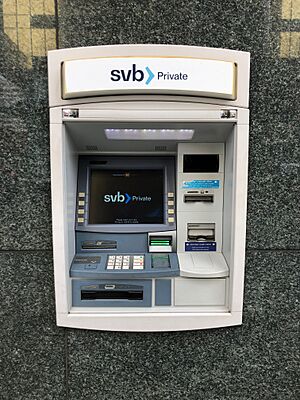Collapse of Silicon Valley Bank facts for kids

On March 10, 2023, Silicon Valley Bank (SVB) failed after many customers quickly took out their money. This event, known as a bank run, was one of the biggest bank failures in United States history. It was also one of three banks that failed in March 2023, along with Silvergate Bank and Signature Bank.
SVB had invested a lot of its money in long-term bonds. The value of these bonds dropped when the Federal Reserve raised interest rates to control rising prices. This meant the bank was losing money on its investments. Also, some of SVB's clients, many of whom were tech companies, started taking out their money to cover their own costs. To get cash, SVB announced on March 8 that it had sold over $21 billion in investments and planned to sell more stock. This news, along with warnings from important investors, caused a huge bank run. Customers quickly withdrew $42 billion by the next day.
On March 10, the California government took control of SVB and put it under the care of the Federal Deposit Insurance Corporation (FDIC). The FDIC usually insures deposits up to $250,000. However, about 89% of SVB's $172 billion in deposits were more than this amount. Two days later, the government decided that all depositors, even those with large amounts, would get their money back. The FDIC reopened the bank on March 13 as a new "bridge bank" called Silicon Valley Bridge Bank, N.A. This was done to sell the bank's assets and pay back depositors without using taxpayer money.
The collapse of SVB greatly affected many startup companies in the U.S. and other countries. Many of them could not get their money out of the bank for a short time. Other large technology companies, media companies, and even wineries were also impacted. For many business founders and their investors, SVB was their main bank.
Contents
What Was Silicon Valley Bank?
SVB was a commercial bank that started in 1983. Its main office was in Santa Clara, California. When it failed, SVB was the 16th largest bank in the U.S. It mostly served companies and people in the technology industry. Almost half of all U.S. tech and healthcare companies that received money from venture capital firms worked with SVB.
Big companies like Airbnb, Cisco, Fitbit, Pinterest, and Block, Inc. were clients of the bank. SVB also offered special services like private banking and loans to tech business owners. It was known for lending money to newer, higher-risk companies. SVB often required companies borrowing from them to use only their bank. Before March 9, 2023, SVB was considered financially "sound." However, some investors had started betting against SVB's stock earlier in the year.
At the end of 2022, SVB had $209 billion in total assets. It held $175.5 billion in deposits. The bank estimated that about $151.6 billion (86.4%) of these deposits were not insured by the FDIC.
Why the Bank Collapsed
Investment Losses
SVB's deposits grew a lot from $62 billion in March 2020 to $124 billion in March 2021. This happened partly because of the impact of the COVID-19 pandemic on science and technology. The bank invested most of these new deposits in long-term Treasury bonds. They hoped to earn more money this way than from shorter-term bonds.
However, as interest rates went up in 2022 and 2023, the market value of these long-term bonds dropped. This made them less attractive compared to newer bonds. The bank's chief risk officer, who helps manage risks, left in April 2022. A new one was not named until January 2023, which was during the time interest rates were rising.
By the end of 2022, SVB had a bond portfolio worth $117 billion. A large part of this was held in bonds that were not regularly valued at their current market price. This meant that any losses would not be officially recorded until the bonds were sold or matured. At that time, the bank had over $15 billion in losses on these bonds that were not yet officially recorded.
Money Withdrawals
At the same time, many startup companies started taking their money out of SVB. They needed cash to run their businesses because it became harder to get private funding. Also, many tech companies had layoffs in 2022, which caused people to use their savings.
In early 2023, to get cash for these withdrawals, SVB sold all of its "available-for-sale" investments. This resulted in a $1.8 billion loss for the bank. Some experts criticized the bank for announcing this sale right after another bank, Silvergate Bank, which served cryptocurrency users, began closing down.
Some banking experts believe that a law passed in 2018, called the Economic Growth, Regulatory Relief, and Consumer Protection Act, played a role. This law reduced how often some banks, like SVB, had to do stress tests. Stress tests check if banks can handle difficult financial situations.
Growing Instability
In 2021, the Federal Reserve reviewed SVB and found problems with how it managed risks. The bank did not fix these issues, and in July 2022, it was put under a full review. Federal Reserve officials met with SVB leaders to talk about how the bank would get cash in a crisis and its risks from rising interest rates. They found that SVB's models were flawed, making the bank believe rising interest rates would help its finances.
In the week before the collapse, a credit rating agency, Moody's, told SVB that its credit rating might be lowered. On March 8, 2023, SVB announced it had sold over $21 billion of its investments, borrowed $15 billion, and would sell $2.25 billion in new stock. Despite these actions, Moody's lowered SVB's rating.
Investors at several venture capital firms, including Founders Fund, told their companies to take their money out of SVB. By the end of March 9, customers had withdrawn $42 billion. This left the bank with a negative cash balance. The value of SVB's shares dropped sharply, and trading was stopped on March 10.
Government Takes Control
On the morning of March 10, government examiners arrived at SVB. A few hours later, the California Department of Financial Protection and Innovation took control of SVB. They said the bank did not have enough cash and was unable to pay its debts. The bank was then placed under the care of the Federal Deposit Insurance Corporation (FDIC). This was the largest bank failure since the 2007–2008 financial crisis.
Most of SVB's deposits were not insured by the FDIC. At first, the FDIC said it would only guarantee insured deposits. However, because of concerns about other banks, the U.S. Treasury allowed the FDIC to guarantee all deposits, both insured and uninsured. On March 13, the FDIC moved SVB's assets to a new "bridge bank" called Silicon Valley Bridge Bank, N.A. This made it easier to find a buyer for the bank.
There was some debate about whether this government action was a "bailout." President Joe Biden said it was not a bailout for the bank itself, its management, or its shareholders. Instead, it was to make sure all depositors got their money back by selling the bank's assets.
SVB also had offices in other countries. The Bank of England took action to manage SVB's UK branch. Canadian regulators also took control of SVB Canada.
The holding company of Silicon Valley Bank, SVB Financial Group, was greatly affected. It eventually filed for Chapter 11 bankruptcy. The estimated cost to the Deposit Insurance Fund to cover the bank's collapse was about $20 billion.
Who Bought SVB?
On March 13, 2023, HSBC UK announced it would buy Silicon Valley Bank UK for a very small amount (£1). This meant depositors in the UK were fully protected.
Then, on March 26, 2023, the FDIC announced that First Citizens BancShares would buy most of SVB's commercial banking business. As part of this deal, First Citizens took over about $119 billion in deposits and $72 billion of SVB's loans. SVB's 17 branches reopened the next day as part of First Citizens Bank. All SVB depositors became customers of First Citizens. This acquisition helped First Citizens become one of the top 20 largest banks in the United States.
Impact of the Collapse
Experts initially thought SVB's collapse would not cause a big problem for the entire U.S. financial system. However, it did create difficulties for some tech startups. Companies with a lot of uninsured deposits and little cash faced big risks.
Impact on Customers

Many startups could not get their money, which made it hard for them to pay their employees. If they couldn't access their deposits, many startups might have had to lay off workers or even close down. The collapse also made it harder for startups to get loans.
Companies like streaming service Roku, Inc. revealed that a quarter of their cash, about $487 million, was held at SVB. Other affected companies included video game developer Roblox Corporation, video hosting service Vimeo, and payroll company Rippling. More than 1,500 climate change technology startups also had loans or credit lines with SVB.
Outside of tech, media companies like Vox Media and BuzzFeed also had money at SVB. Vox Media's SVB credit cards even stopped working. The California wine industry was also affected, as SVB was a major bank for wineries in the region.
SVB had also provided loans and investments for affordable housing projects in Silicon Valley and San Francisco. The bank's failure left 11 housing projects in the San Francisco Bay Area in doubt. Some nonprofit organizations also faced challenges.
SVB's holding company, SVB Financial Group, was part of a major stock market index, the S&P 500. Large investment firms like The Vanguard Group and BlackRock were among its biggest shareholders. After the collapse, shares of other similar regional banks, such as First Republic Bank, also dropped.
The total value of U.S. banks in the stock market fell by $100 billion in two days. SVB's losses showed that banks could face problems when interest rates rise and reduce the value of their bond investments. Some companies moved their money to larger banks, which raised concerns about stability in the banking sector.
Despite these worries, many banking experts believed other banks would remain stable. They pointed out that SVB was very specialized in serving a risky part of the economy. Also, financial rules have been made stronger since the 2008 financial crisis.
The Federal Reserve created a new program, the Bank Term Funding Program, to help other banks get cash if needed. The collapse also affected the price of USD Coin (USDC), a type of digital currency, because its issuer, Circle, had some of its cash reserves at SVB.
Official Responses and Debates
Government Actions
U.S. President Joe Biden spoke about the collapse, saying he was confident in the banking system. He promised that the government would make sure deposits were available without using taxpayer money to reward investors. He also said he would hold bank executives responsible and propose new rules to prevent future failures.
Leaders in other countries, like Israel, India, the UK, and Japan, also spoke about the situation. They mostly said that their own financial systems were not at high risk.
Debate Over Government Help
Many investors and business leaders asked the government to step in and protect all uninsured depositors. They argued that it was important to keep the economy stable. However, some politicians and experts disagreed, saying that protecting large depositors might encourage risky behavior by banks in the future. They called this a "moral hazard."
President Biden and Treasury Secretary Janet Yellen said the government's actions were not a "bailout" because they were not saving the bank itself, but rather protecting the depositors. Some critics, however, still called it a bailout.
Debate About Causes
Michael Barr, a top official at the Federal Reserve, said SVB failed because its management did not properly handle its risks. He said the bank suffered a "devastating and unexpected run" by its uninsured depositors in less than 24 hours. He also noted that Federal Reserve supervisors had warned the bank about problems as early as November 2021, but the bank did not fix them quickly.
An official report from the FDIC and Federal Reserve suggested that changes to banking rules and less strict enforcement allowed the bank's mismanagement to cause its failure.
Some politicians argued that the bank's failure could have been avoided if it had been required to do regular stress tests, which were reduced by the 2018 law. They called for this law to be changed.
Some conservative commentators suggested that the bank failed because it was too focused on social issues like diversity, equity, and inclusion (DEI) programs. However, investigations by news organizations found no evidence to support these claims.
See also
- Bank regulation in the United States
- Deposit insurance
- List of bank failures in the United States (2008–present)


